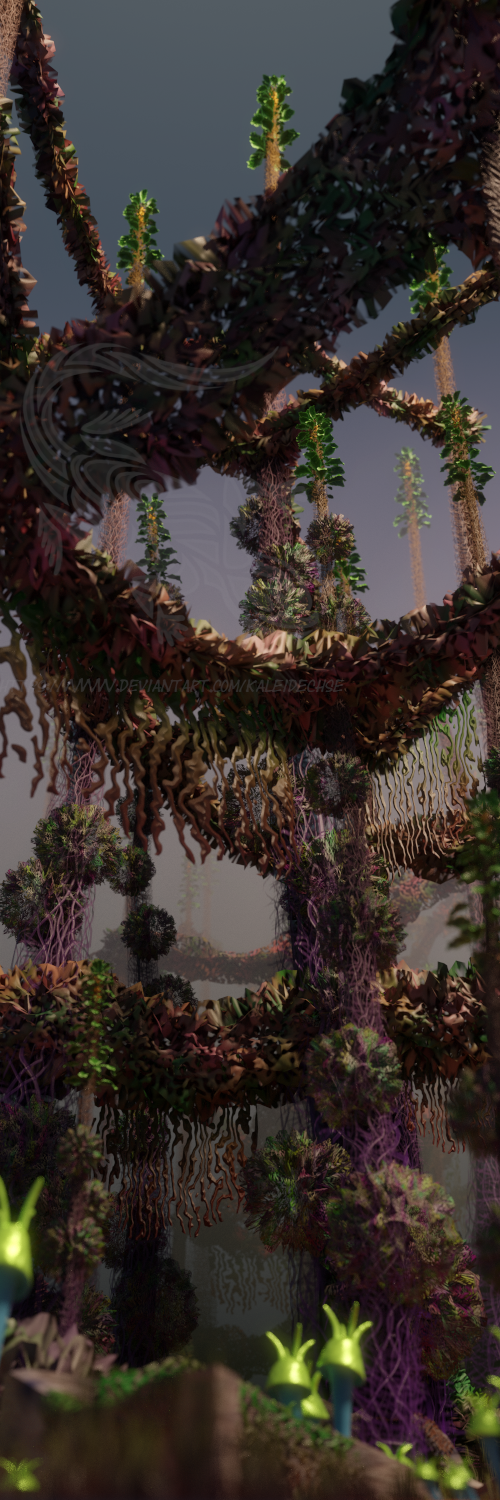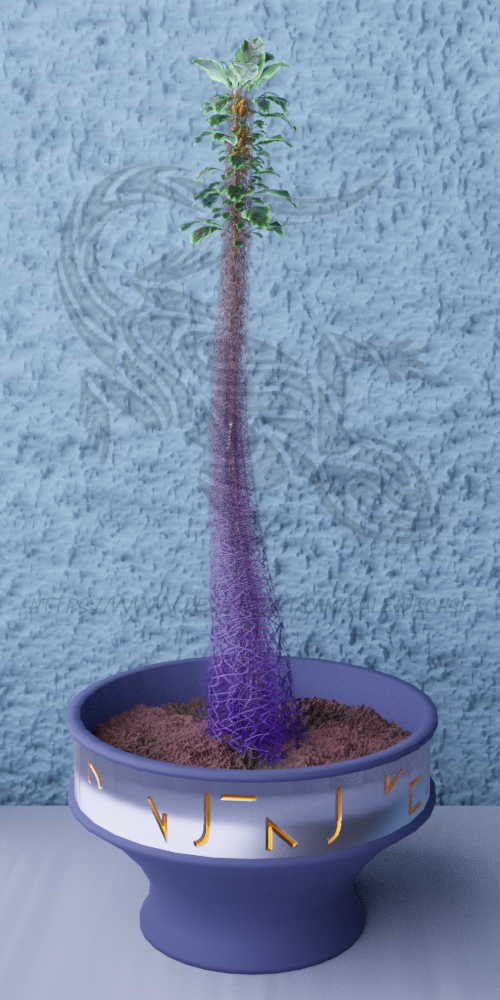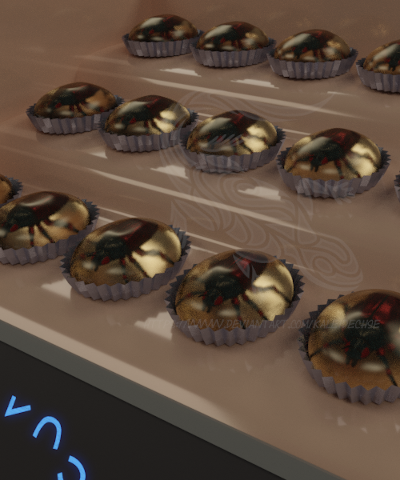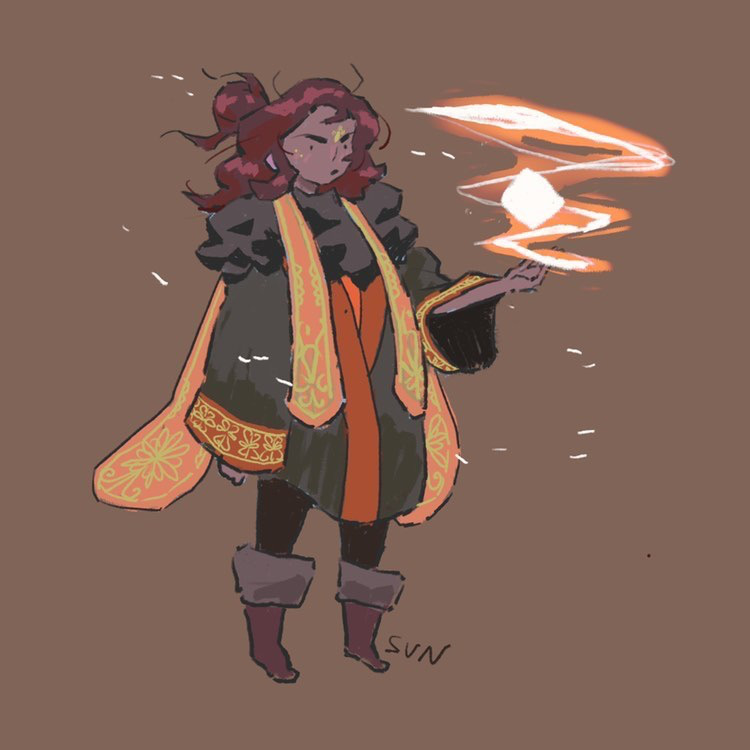
A carnivorous tree which grows among the ruins of the Southwestern Missile Base.
The tree's "trunk" is an irregular structure of branching and interlocking vines. Between these vines, numerous holes lead inside where a web of fibers is soaked in a sugary sap. Said sap is produced in lumpy, bulging sections near the top, located amidst large, gnarled leaves.
The color of the fibrous vines ranges from a yellowish brown to a deep, dark purple. The latter is concentrated near the ground, where it aids in attracting ground-dwelling insects. The leaves are of a medium green which pales towards the edges, and covered in specks of a reddish purple.
Umpu Deraksi release their pollen during the Heat Season, letting the torrents of rain wash them down to the ground. There, the pollinated water fertilizes special germination nodes along the roots. New vine clusters form at these nodes, between 2 and 12 meters away from the parent tree. They sprout up from the soil around the middle of Zadrunoma.
Young vine clusters grow about 5 meters tall within the first year. The growth rate slows down to about 2 meters per year as the plant matures.
New vines will keep branching off from the existing ones throughout the tree's lifetime, weaving themselves around and through the others. The trunk grows thicker and more stable as a result, which in turn allows it to reach greater heights.
The oldest Umpu Deraksi in the wild can be dated back to the destruction of the missile base in 2 NZR, making them over 820 years old. The tallest plant measures about 140 meters, with a diameter of nearly 11 meters at the base.
This type of plant is native to the jungle surrounding the ruins of the Southwestern Missile Base. The current scientific consensus is that it evolved in the aftermath of the site's destruction, from trees which mutated due to the high radiation levels.
Genetic analysis revealed that its ancestors lost the ability to form coherent trunks due to DNA damage. Furthermore, the region must have severely lacked in nutrients after most of its lifeforms were either incinerated in the explosion or died due to radiation poisoning. Evolutionary selection consequently favored those trees whose fibrous trunks were able to trap insects.
Umpu Deraksi literally means "cage-like trunk", hinting at both the plant's appearance and its manner of feeding.
The sugary sap inside the trunk lures various small insects into the mesh of vines. On the way in, they get entangled in the fibers which trap them there until they starve. The same fibers then serve to absorb the insects' bodies as they are decomposed by microorganisms.
Miniature versions of these trees are popular house plants for busy people. Not only do they require little maintenance, they also have the added benefit of trapping and disposing of vermin. Certain subspecies have even been bred to attract insects which are more common in urban areas, such as the blood-sucking rontul.
The house plants' build tends to be much stockier than that of wild specimens, and the leaves appear larger in comparison to the trunk. Their growth is significantly slowed down via genetic engineering, keeping them at a size that fits into the average household.
The jungle marked by these trees stretches along the northwestern coast of the Zugnur Sea. It covers an area of about 40 by 120 kilometers, with the ruins of the missile base located roughly in the center.
Most of the recovering ecosystem formed around the Umpu Deraksi. There are several epiphytic species which grow in the mesh-like trunks, fungi which decompose their fallen leaves or climbing plants which use them as scaffolding to reach the light.
Many of the larger insects use the fibres as building material for their nests, while some reptile species dig into the cavities to scavenge half-digested prey or drink the sap itself. The trees are fairly tolerant to the associated damage. Botanists believe that, due to the highly mutagenic environment, breaking and otherwise ill-formed vines were common around the time of the Final War. As a consequence, the Umpu Deraksi evolved to regenerate quickly.
Lifespan
~ 600 - 800 years and beyond
Conservation Status
nature reserve / memorial site
Average Height
60 - 100 m
The Kaleidoscope System is being developed by Kathrin Janowski a.k.a. Kaleidechse.
Unless otherwise stated, all artworks are created by myself.
All rights reserved.
Unless otherwise stated, all artworks are created by myself.
All rights reserved.
Cover image:
by
Kathrin Janowski
Comments
Please Login in order to comment!











This is a great article! It is very clean and easy to read and you have amazing images to illustrate it. And your table of content is amazing, that's a great css! I love your plant, it sounds very realistic. This is a great origin story that you have for your plant. I love the idea of having it as a potted plant inside houses! " fungi which decompose their fallen leaves or climbing plants which use them as scaffolding to reach the light." I think you mean "using them" instead of "which use" The larger insects do not get trap by the fibres? Do you have examples of those insects or are they all different species from the one we have? Or it could be some insect species that learn to deal with the sticky fibres, like some insect know to put dirt on top of sticky substance to protect themselves. Aww. I like the details about the food, but that sounds absolutely horrible XD (and very nice creepy picture to go with it XD) When you say "Ointments that stimulate cell regeneration are a staple in modern first aid kits, whereas larger wounds or broken bones are usually mended by implanting lab-grown micro-vines as scaffolding." You don't say it directly, but I'm guessing the ointment is made from the plant? Or do they just purify a chemical from it/ used the plant as an inspiration for he chemical and now synthetise it in the lab? I love the idea of using micro-vines as scaffolding. Is it like the real vines but smaller, or something artificial inspired by it? Also, does that mean that the vine stays inside the body, right? Do they die off after a while and the body just get rid of them? Or do they just stay there permanently? That's a really fascinating idea, for people to go around with bits of vine inside their body… Though if it's real vine, how can they stop it from growing everywhere inside the body?
Thank you so much for this in-depth feedback! <3 I'm happy that you enjoyed this article. Insects on Ranul can get huge. I imagine the "larger insects" mentioned here to be around the size of a crow, strong enough to tear the fibres out. I haven't got examples yet, but I might add some later. Sorry about the creepy imagery. ;D Rilsu eat a lot of insects because that moon does not have birds or mammals. Also, because alien lizard people may have different ideas of what is edible than we do... Regarding the medical applications: I haven't figured out the details yet, but I'd love to make additional articles for that. I suppose the components are produced in a lab, using genetically-modified plant material. The micro-vines implanted in the body are designed to dissolve slowly so that the body can get rid of them when their support is no longer needed.
Creator of the Kaleidoscope System and the planet Miragia.